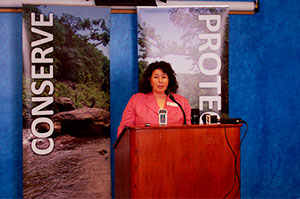Oklahoma a National Leader in Pollution Reduction to Streams

A recent comparison of EPA priority nonpoint source pollutant reduction numbers from across the nation shows that Oklahoma ranks as the number two state in the nation when it comes to reducing harmful nutrients from our streams and rivers. This is the fifth year in a row that Oklahoma has ranked in the top ten among states in reported non-point source nutrient reductions according to Kim Farber, President of the Oklahoma Association of Conservation Districts (OACD).
“This continued improvement in water quality is a testimony to the success of the dedicated, voluntary work done by farmers, ranchers and other landowners in partnership with the Oklahoma Conservation Commission, local conservation districts, Environmental Protection Agency (EPA) Clean Water Act 319 programs and the USDA Natural Resources Conservation Service (NRCS) to address this critical issue,” Farber said. “This success shows what can happen when we work together, respect individuals’ private property rights and when the State and Federal Governments give landowners the financial and technical assistance they need to make changes. Locally-led, voluntary conservation works.”

Water quality numbers recently reported by States to the EPA show that in 2013, Oklahoma’s Nonpoint Source Program led the nation in phosphorus reduction for the third year in a row with more than 1,036,393 pounds of estimated phosphorus load reduced due to voluntary best management practices across the state. The number reflects over 30% of the overall reported reductions of phosphorus in surface water in the entire United States.
In addition, Oklahoma ranked second among the states in reported nitrogen load reduction to streams—an estimated 1,420,749 pounds of nitrogen last year. Oklahoma also had an estimated sediment reduction of over 9,732 tons to streams. When these numbers are reviewed in EPA’s Grants Reporting and Tracking System (GRTS) database, comparison with the levels of nonpoint source pollution reduced by other states shows that Oklahoma ranks number two overall in the reduction of nutrients that pollute our water. This is the fifth year in a row where Oklahoma has ranked in the top ten among states in reported reduction of nitrogen and phosphorus loads, while receiving less than two percent of EPA 319 program funds.
According to Clay Pope, Executive Director of OACD, this reduction shows the success of locally-led conservation efforts in addressing non-point source pollution and helps highlight why locally-led incentive based programs are critical to ongoing efforts designed to address water quality both at the state and federal level.
“By using the delivery system consisting of the Oklahoma Conservation Commission, local conservation districts and NRCS, we have been able to use EPA 319 Federal Clean Water Act dollars and Farm Bill Conservation Title funds along with state dollars to partner with landowners in ways that are starting to turn the corner on some of Oklahoma’s toughest water quality problems,” Pope said. “We’re not only controlling pollution, but we are also taking into consideration the financial situation of the local landowner. Clearly we have a great model and all Oklahoman’s should be proud of this work. We have more to do, but we are moving in the right direction in Oklahoma when it comes to water quality. This is the same kind of approach we used to tame the Dust Bowl of the 1930’s, and it shows what can be done when landowners and the government work cooperatively together to solve these kinds of problems.”
Download this article as a PDF.
Learn how the Conservation Commission is Keeping Oklahoma Beautiful!
